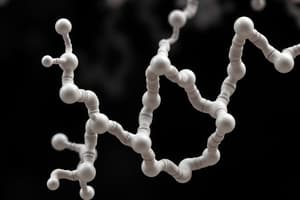Podcast
Questions and Answers
Which of the following statements is true about polar acidic amino acids?
Which of the following statements is true about polar acidic amino acids?
- They contain only one amino group.
- They have a positive charge at physiological pH.
- They contain two carboxyl groups. (correct)
- They are hydrophobic at physiological pH.
All polar neutral amino acids are water-fearing.
All polar neutral amino acids are water-fearing.
False (B)
Name two polar acidic amino acids.
Name two polar acidic amino acids.
Aspartic acid and glutamic acid
A non-polar amino acid is characterized by a ________ side chain.
A non-polar amino acid is characterized by a ________ side chain.
Which amino acids are categorized as polar basic?
Which amino acids are categorized as polar basic?
At physiological pH, polar basic amino acids have a negative charge.
At physiological pH, polar basic amino acids have a negative charge.
How many polar neutral amino acids are there?
How many polar neutral amino acids are there?
Match the amino acid type with its correct characteristic:
Match the amino acid type with its correct characteristic:
Which type of protein does not contain adequate amounts of essential amino acids?
Which type of protein does not contain adequate amounts of essential amino acids?
Glycine is the only standard amino acid that is chiral.
Glycine is the only standard amino acid that is chiral.
What do you call an essential amino acid that is missing or present in inadequate amounts in a protein?
What do you call an essential amino acid that is missing or present in inadequate amounts in a protein?
Most animal proteins are considered __________ proteins because they contain all essential amino acids.
Most animal proteins are considered __________ proteins because they contain all essential amino acids.
What type of dietary protein combines two or more incomplete proteins to provide adequate essential amino acids?
What type of dietary protein combines two or more incomplete proteins to provide adequate essential amino acids?
Match each type of protein to its description:
Match each type of protein to its description:
All standard amino acids are derived from a specific chirality.
All standard amino acids are derived from a specific chirality.
Name one complete source of dietary protein.
Name one complete source of dietary protein.
What happens to the zwitterion in an acidic environment?
What happens to the zwitterion in an acidic environment?
Cysteine can dimerize in the presence of strong oxidizing agents.
Cysteine can dimerize in the presence of strong oxidizing agents.
What defines the isomeric forms of amino acids in Fischer projections?
What defines the isomeric forms of amino acids in Fischer projections?
A molecule that has both a positive and negative charge but no net charge is called a __________.
A molecule that has both a positive and negative charge but no net charge is called a __________.
Match the amino acids with their characteristics:
Match the amino acids with their characteristics:
What is the isoelectric point?
What is the isoelectric point?
Most amino acids are highly soluble in water.
Most amino acids are highly soluble in water.
What bond links two cysteine residues?
What bond links two cysteine residues?
What type of protein contains multiple peptide chains?
What type of protein contains multiple peptide chains?
A simple protein contains only amino acid residues.
A simple protein contains only amino acid residues.
What is the C-terminal end of a peptide chain characterized by?
What is the C-terminal end of a peptide chain characterized by?
A peptide bond is formed between the _____ group of one amino acid and the _____ group of another amino acid.
A peptide bond is formed between the _____ group of one amino acid and the _____ group of another amino acid.
Which of the following is NOT a rule in peptide nomenclature?
Which of the following is NOT a rule in peptide nomenclature?
Match the following types of proteins with their descriptions:
Match the following types of proteins with their descriptions:
Hemoglobin is an example of a simple protein.
Hemoglobin is an example of a simple protein.
Identify the suffix used for all amino acid residues except for tryptophan, cysteine, glutamine, and asparagine in peptide nomenclature.
Identify the suffix used for all amino acid residues except for tryptophan, cysteine, glutamine, and asparagine in peptide nomenclature.
Which type of protein includes a carbohydrate group?
Which type of protein includes a carbohydrate group?
The primary structure of a protein can vary depending on its location in the organism.
The primary structure of a protein can vary depending on its location in the organism.
What kind of bond is formed between the -SH groups of two cysteine residues?
What kind of bond is formed between the -SH groups of two cysteine residues?
The arrangement in space adopted by the protein backbone is known as the ________ structure.
The arrangement in space adopted by the protein backbone is known as the ________ structure.
Match the type of protein with its characteristic component:
Match the type of protein with its characteristic component:
What type of protein is responsible for carrying oxygen in our blood?
What type of protein is responsible for carrying oxygen in our blood?
Hydrophobic attractions involve polar side chains coming together.
Hydrophobic attractions involve polar side chains coming together.
Name one example of a metalloprotein.
Name one example of a metalloprotein.
Flashcards are hidden until you start studying
Study Notes
Non-Polar Amino Acids
- Contain one amine group, one carboxyl group, and a non-polar side chain.
- When incorporated into proteins, they exhibit hydrophobic properties.
Polar Acidic Amino Acids
- Contain one amino group and two carboxyl groups; one carboxyl is part of the side chain.
- At physiological pH, the side chain carries a negative charge.
- Examples: aspartic acid and glutamic acid.
Polar Basic Amino Acids
- Feature two amino groups and one carboxyl group, with the second amino group in the side chain.
- The side chains are positively charged at physiological pH due to proton acceptance.
- Examples: lysine, arginine, and histidine.
Polar Neutral Amino Acids
- Comprise one amino group, one carboxyl group, and a polar but neutral side chain.
- These amino acids are more soluble in water than nonpolar amino acids.
- There are six polar neutral amino acids.
Incomplete Dietary Protein
- Lacks sufficient essential amino acids to meet the body's requirements.
Limiting Amino Acids
- Essential amino acids that are deficient or absent in an incomplete dietary protein.
Essential Amino Acids
- Must be obtained through diet; the body cannot synthesize these amino acids.
Chiral Amino Acids
- All standard amino acids except glycine are chiral, having four different groups attached to the α-carbon.
Complete Dietary Protein
- Contains all essential amino acids in sufficient quantities.
- Most animal proteins, including casein, meats, fish, and eggs, are complete proteins.
Fischer Projection
- The carboxyl group is placed at the top with the R group at the bottom.
- Horizontal position of the amino group indicates L- or D-isomer.
Isoelectric Points
- The pH at which amino acids exist primarily in zwitterion form, carrying no net charge.
Cysteine
- Contains a sulfhydryl group in its side chain.
- Can form covalent disulfide bonds with other cysteine residues.
Acid-Base Properties of Amino Acids
- Typically white crystalline solids with high decomposition points.
- Generally low solubility in water.
Zwitterion
- A molecule with both positive and negative charges, net charge equals zero.
- Changes in pH affect the zwitterionic form of amino acids.
Peptide Bond
- Covalent bond between the carboxyl group of one amino acid and the amino group of another.
- Backbone consists of repeating peptide bonds and α-carbon groups.
Protein Classification
- Monomeric Protein: Contains only one peptide chain.
- Multimeric Protein: Contains multiple peptide chains.
- Simple Protein: Consists solely of amino acid residues.
- Conjugated Protein: Contains additional non-amino acid components.
Peptide Nomenclature
- C-terminal amino acid retains full name, others use -yl suffix.
- Naming starts from the N-terminal amino acid.
General Structural Characteristics of Proteins
- Primary Structure: Sequence of amino acids; linked by peptide bonds.
- Secondary Structure: Spatial arrangement adopted by the backbone.
- Tertiary Structure: Overall shape formed by further folding.
Interactions Responsible for Tertiary Structure
- Covalent Disulfide Bonds: Strongest interactions formed between cysteine residues.
- Electrostatic Attractions: Occur between oppositely charged side chains.
- Hydrogen Bonds: Formed between polar R groups.
- Hydrophobic Attractions: Occur between nonpolar side chains bringing them together.
Studying That Suits You
Use AI to generate personalized quizzes and flashcards to suit your learning preferences.




